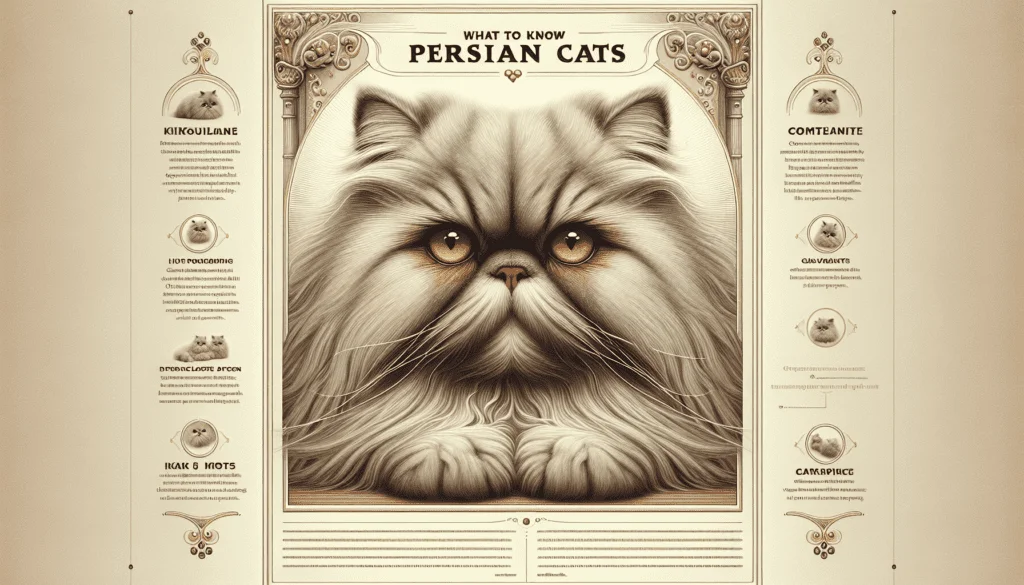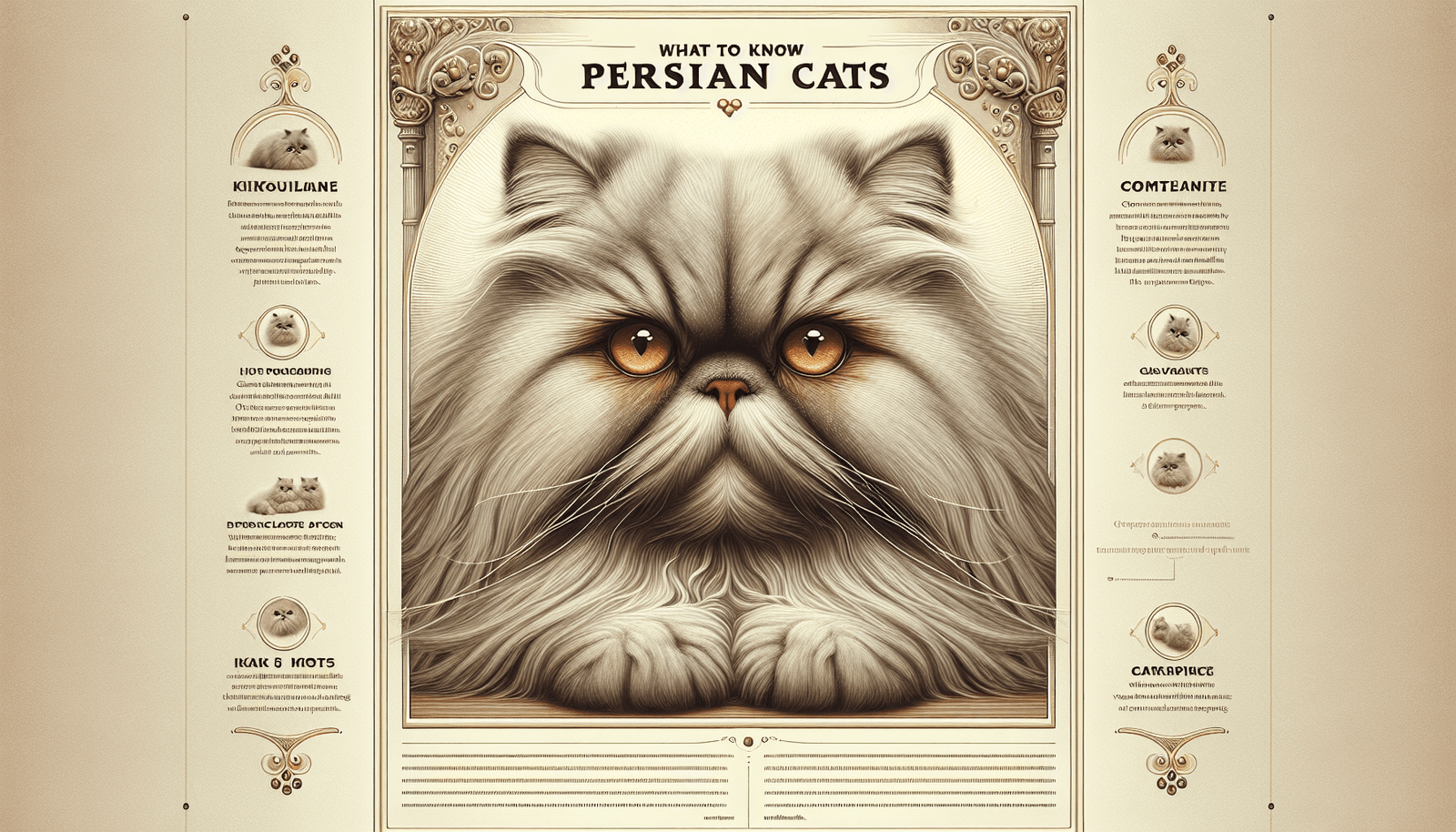If you’ve ever been charmed by the majestic grace and fluffiness of a Persian cat, you’re not alone. These enchanting felines have captured the hearts of cat lovers around the world. In this article, we will uncover the key aspects and fascinating traits that make Persian cats so special. From their luxurious long fur to their renowned calm and gentle nature, you’re about to embark on a journey into the captivating world of Persian cats. So, get ready to discover what truly sets these remarkable creatures apart.

Appearance
Persian cats are known for their distinctive physical features that set them apart from other cat breeds. With their unique facial structure, they have a flat face and a short nose, giving them a distinctive look. Their large round eyes are one of their most striking features, often shining with a gentle and sweet expression. Persian cats come in a wide variety of coat colors and patterns, ranging from solid colors like black, white, and cream, to more intricate patterns such as tabby and calico. These beautiful coats make them quite the eye candy!
Personality
When it comes to personality, Persian cats are known for their gentle and affectionate nature. They are generally laid-back and have a quiet and calm demeanor. Unlike some other cat breeds, Persian cats prefer a peaceful environment and may become stressed in a chaotic household. They are loving and enjoy the company of their humans, craving attention and companionship. Spending time with your Persian cat, whether it’s snuggling on the couch or playing with them, is sure to bring you both joy and comfort.
Grooming
Persian cats have long and dense fur, which requires regular grooming to keep it in a pristine condition. Daily brushing is essential to prevent matting and knots, as their fur is prone to tangling. Regular bathing is also necessary to maintain their hygiene and keep their coat healthy. Additionally, Persian cats require special attention when it comes to their eyes and ears. Their eyes can be prone to tearing, so gently cleaning them with a soft cloth or cotton pad is important. Similarly, their ears should also be checked regularly and cleaned to prevent any infections or buildup.
Health
While Persian cats are generally healthy, like any breed, they have their own set of potential health concerns. Due to their facial structure and shorter nose, they are susceptible to respiratory problems, including snoring and difficulty breathing. They are also predisposed to certain genetic diseases, such as polycystic kidney disease and hypertrophic cardiomyopathy. To ensure their well-being, regular veterinary check-ups are crucial for monitoring their health and catching any potential issues early on. Additionally, providing them with a proper diet and nutrition tailored to their needs will help them thrive.

Exercise and Play
Persian cats are known for their low-energy nature and preference for relaxed activities. While they may not be as active as some other cat breeds, it is still important to provide them with opportunities for exercise and play. Indoor play options, such as interactive toys and scratching posts, can help keep them entertained and prevent boredom. Mental stimulation is also key for their well-being, so engaging them in puzzle toys or teaching them simple tricks can be a great way to keep their minds sharp.
Living Environment
Persian cats are well-suited for apartment living due to their calm and quiet nature. However, it is important to create a safe and stimulating environment for them. Providing them with cozy spots to nap, such as soft beds or blankets, will help them feel secure. Avoiding extreme temperatures is crucial, as Persian cats are sensitive to heat and cold. Keeping them in a comfortable temperature all year round will ensure their comfort. Minimizing stress and anxiety triggers, such as loud noises or sudden changes in their environment, is also important for their well-being.
Training
Training a Persian cat requires patience and consistency. Using positive reinforcement, such as treats and praise, is an effective way to encourage desired behaviors and discourage unwanted ones. Litter box training is an important aspect of owning a Persian cat, as they are naturally clean animals. Introducing them to a litter box early on and keeping it clean will help them develop good bathroom habits. Behavioral training can also be beneficial to discourage scratching on furniture, providing them with appropriate scratching posts and redirecting their behavior.
Interaction with Children and Other Pets
Persian cats are generally good with children, thanks to their gentle and affectionate nature. However, supervised playtime is important to prevent accidental harm, as children may not always understand the cat’s boundaries. Slow and gradual introductions should be done when introducing Persian cats to other pets. Persian cats can be territorial and may take time to adjust to the presence of other animals in their space. Providing them with their own safe area and gradually allowing them to interact can help foster positive relationships.
Famous Persian Cats
Throughout history, Persian cats have made their way into the spotlight with their unique charm. Some notable Persian cats include:
- Choupette: Karl Lagerfeld’s beloved cat and a fashion icon in her own right.
- Maru: An internet sensation known for his adorable antics and love for boxes.
- Oliver: The title character of the Disney film ‘Oliver & Company,’ who captured hearts with his endearing personality.
- Mr. Bigglesworth: The famous hairless Persian cat who appeared in the ‘Austin Powers’ movie series, adding a touch of humor to the films.
Responsible Ownership
Owning a Persian cat is a lifelong commitment that requires responsible ownership. Proper socialization from a young age is essential to help Persian cats become comfortable with various situations and people. Spaying/neutering is highly recommended to prevent overpopulation and unwanted behaviors. Providing a safe and enriching environment with plenty of toys, scratching posts, and cozy spots to rest will help them thrive. Regular veterinary care, proper nutrition, and lots of love and attention are crucial to ensure the health and happiness of your Persian feline companion.

